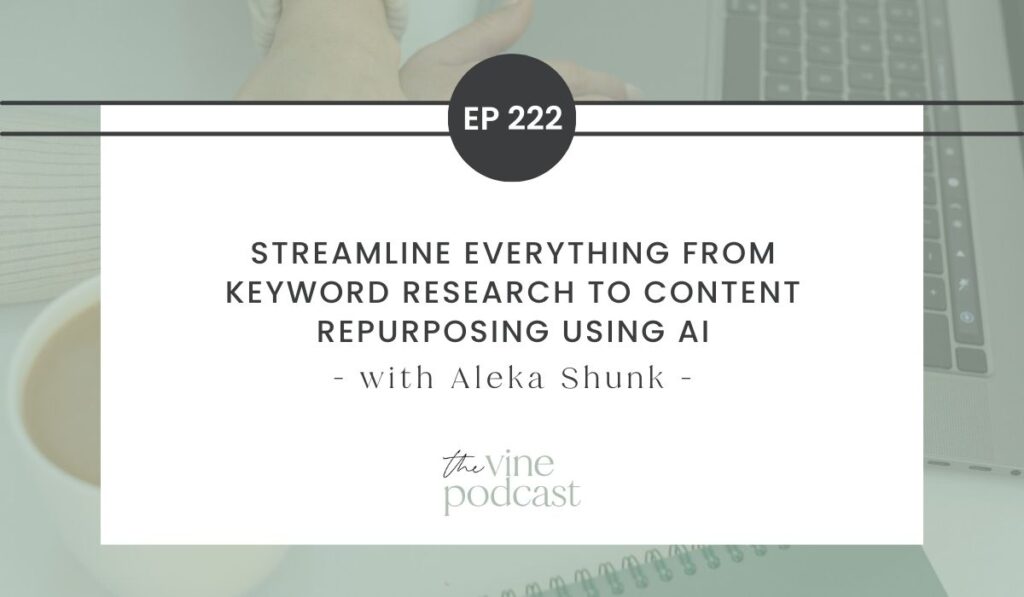Are you spending 2-3 hours writing every single blog post, only to feel like you’re creating the same monotonous content over and over again? What if I told you there’s a way to cut that time in half while actually making your content more interesting and unique?
Many food bloggers are hesitant to embrace AI tools, worried they’ll end up sounding robotic or generic. But here’s the irony: most of us have already been writing the same formulaic posts for years. The same outline structure, the same headers, the same predictable flow from ingredients to instructions to variations.
AI isn’t here to replace your creativity—it’s here to amplify it and free you from the tedious parts of content creation so you can focus on what you do best: sharing your passion for food and connecting with your audience.


The Pre-AI Content Creation Struggle
Before diving into solutions, let’s acknowledge the reality of traditional content creation. Most food bloggers follow a predictable pattern:
- What’s different about this recipe
- Why I love this recipe
- Ingredients list
- Instructions
- Variations and substitutions
- FAQs
Sound familiar? This cookie-cutter approach leads to content that feels stale—both for you as the creator and for your readers. You get tired of writing the same structure, and your content starts blending together with every other food blog out there.
The traditional process is also incredibly time-consuming. From keyword research to outlining, writing, editing, and promotion, creating one blog post can easily consume an entire day.
A 5-Stage Framework for AI-Powered Content Creation
Eleka Shunk, the creator of Learn with Eleka (formerly Keywords with Eleka), has developed a systematic approach to using AI tools like ChatGPT or Claude that transforms content creation from a tedious chore into an efficient, creative process.
Stage 1: Keyword, Topic, and Ideation
This stage goes beyond basic keyword research. You start with a primary keyword (like “strawberry shortcake”) and use AI to explore different angles and opportunities you might never have considered.
Key Prompt to Try: “Here is my primary keyword: [your keyword]. Generate 10 SEO-optimized blog post ideas that reflect high user intent and are likely to perform well in search results. Include suggested title formats and post types (listicle, how-to, guide, comparison, etc.) that fit each idea best.”
Powerful Follow-up Prompts:
- What are the most searched questions related to this keyword?
- What longer tail keyword variations am I not thinking of?
- What are 10 different content angles I can take for this topic?
- What common pain points do people have around this keyword?
- How many different pieces of content can I create on this topic to build topical authority?
This approach helps you build content clusters and establish topical authority—something Google increasingly values.
Stage 2: Generate Your SEO Outline
This is where the magic happens. Instead of using the same tired outline structure, AI can suggest fresh approaches and angles you’d never consider on your own.
The key is asking AI to analyze top-ranking content, identify gaps, and suggest comprehensive coverage of the topic. Then—and this is crucial—you personalize it by adding your own expertise and unique perspective.
Stage 3: First Draft Creation
With a solid, AI-generated outline in hand, writing your first draft becomes much more focused and efficient. You’re not staring at a blank page wondering what to write next—you have a roadmap.
Stage 4: Optimization and Polish
This stage involves refining your content, optimizing meta descriptions, ensuring proper keyword placement, and adding those final touches that make your content shine.
Stage 5: Content Repurposing
This might be the most valuable stage of all. Once you’ve created one piece of content, AI can help you transform it into multiple formats:
- Email newsletters with compelling subject lines
- Social media posts
- Pinterest descriptions
- Follow-up email sequences
Repurposing Prompt to Try: “I want to turn this blog post into a newsletter. Give me a few different catchy subject lines that will peak interest, then write an informative email that shares some tips and encourages users to click back to the blog post.”

The Real-World Impact: From 3 Hours to 90 Minutes
Eleka reports that this systematic approach has cut her writing time from 2-3 hours per post down to about 90 minutes. But the time savings isn’t the only benefit—the quality and variety of her content has actually improved.
“None of my posts look exactly the same anymore,” she explains. “I have different headers, different H3s. Nothing’s the same order. AI is helping me think of so many different angles and approaches that I never would have thought of.”
Smart Prompting Strategies That Actually Work
Ask AI to Ask You Questions
Instead of giving AI incomplete information and getting mediocre results, try this approach: “I want [specific result]. Ask me whatever questions you need to give me the best possible output.”
This creates a dialogue that leads to much better results because AI can fill in the gaps in your initial request.
Save and Organize Your Best Prompts
When you get a result you love, don’t let that prompt disappear. Ask AI: “Help me write a prompt that would consistently get this type of result.” Then save these refined prompts for future use.
Use Projects for Brand Consistency
If you’re using Claude, create projects that include your brand messaging, tone of voice, and key information about your blog. This ensures AI incorporates your unique brand voice into every piece of content.
Starting Small: Where to Begin
Feeling overwhelmed by the idea of overhauling your entire content process? Start with just one stage.
For Beginners: Try Stage 5 first. Take a blog post you’ve already published and use AI to repurpose it into email content or social media posts. This is less intimidating and gives you immediate value.
Ready for More: Jump into Stage 1 for your next blog post. Use the keyword ideation prompts to explore different angles for a topic you’re already planning to write about.
Beyond Content Creation: Other AI Applications
AI can streamline many other aspects of your blogging business:
- Voice Mode: Use ChatGPT’s voice feature while driving to brainstorm ideas or work through creative blocks
- Email Batching: Create multiple email sequences in minutes
- Content Planning: Develop content clusters and editorial calendars
- SEO Research: Identify content gaps your competitors are missing
The Voice Mode Game-Changer
One feature that’s particularly transformative is voice mode in ChatGPT’s mobile app. You can literally have conversations with AI while driving, walking, or doing other tasks. These conversations save in your chat history, so you can continue them on your computer later.
This makes AI feel less like a tool and more like a brainstorming partner—which is exactly what it should be.

Maintaining Your Authentic Voice
The biggest concern about using AI is losing your authentic voice. But the framework addresses this by:
- Starting with your expertise and perspective
- Using AI to enhance rather than replace your ideas
- Adding personal stories and experiences that only you can share
- Maintaining editorial control over the final content
Remember: AI is suggesting ideas and structures, but you’re still the chef deciding which ingredients to use and how to combine them.
The Future of Content Creation
AI tools aren’t going anywhere—they’re only getting better. Food bloggers who learn to work with these tools now will have a significant advantage over those who resist them.
The goal isn’t to become dependent on AI, but to use it strategically to handle the routine, time-consuming tasks so you can focus on the creative, relationship-building aspects of blogging that truly matter.
As Eleka puts it: “We’re all looking for ways to diversify our income and work more efficiently. AI gives us that opportunity—but only if we’re willing to step outside our comfort zone and learn something new.”
Getting Started Today
If you’re ready to experiment with AI in your content creation process, start small:
- Choose one upcoming blog post
- Try the keyword ideation prompts from Stage 1
- See what new angles or ideas emerge
- Save any prompts that give you useful results
Remember, there will be a learning curve. Your first attempts might take longer than your usual process. But as you develop your prompting skills and build a library of effective prompts, you’ll start seeing the time savings and quality improvements.
The question isn’t whether AI will change content creation—it already has. The question is whether you’ll adapt and use these tools to create better content more efficiently, or continue spending hours on tasks that could be streamlined.
Your readers don’t care how you create your content—they care about the value it provides. AI can help you deliver more value in less time, which benefits everyone: you, your business, and your audience.
Related episode: Using AI to Support Your Blog Growth with Hanelore Dumitrache
Call to Action
Ready to revolutionize your content creation process? Start with one small experiment this week. Try using AI for keyword ideation on your next blog post and see what new angles emerge. What’s the worst that could happen—you might actually enjoy writing again?
If you’ve experimented with AI in your content creation process, I’d love to hear about your experience. What’s worked well for you? What challenges have you encountered? Share your thoughts in the comments below.

Aleka Shunk is an educator, course creator, and former middle school teacher who specializes in helping bloggers master keyword research to increase traffic and revenue. She is the founder of ‘Learn With Aleka’, Formally ‘Keywords With Aleka‘, which is a suite of SEO-focused courses that provide clear, actionable strategies for ranking higher on Google, tracking keywords and using AI to blog smarter. Drawing on over a decade of experience in education and content creation, Aleka has taught thousands of bloggers how to identify high-value keywords, optimize existing content, and create posts that consistently attract the right audience. When she’s not teaching or creating content, Aleka enjoys cooking, entertaining, and spending time with her husband and two sons in Florida.

ready to take your food blog to the next level?
We work with food bloggers looking to stand out of the crowd through custom brand and website design.




Leave a Comment